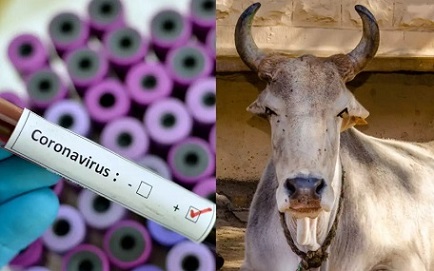COVID-19 News: Chinese Researchers Warn That SARS-CoV-2 Could Be Infecting Cattle and Other Animals Via AXL And NRP1 Receptors!
Nikhil Prasad Fact checked by:Thailand Medical News Team Nov 28, 2023 1 year, 4 months, 2 weeks, 5 days, 16 hours, 4 minutes ago
COVID-19 News: The relentless quest to understand the dynamics of the SARS-CoV-2 virus has taken an intriguing turn with recent findings from the Chinese Academy of Medical Sciences and Peking Union Medical College in Kunming, Yunnan Province, China. The research sheds light on the potential susceptibility of bovines to SARS-CoV-2, driven by interactions with the AXL and NRP1 receptors.

Past studies have only focused on various animal species infections via the ACE2 receptors only.
In this
COVID-19 News report, we delve into the nuances of the study, unraveling the implications for public health, the global food supply chain, and the broader context of zoonotic diseases.
Host Receptor Recognition: ACE2, AXL, and NRP1
At the heart of SARS-CoV-2's ability to infect host cells lies the recognition of specific receptors. While the angiotensin-converting enzyme 2 (ACE2) receptor has been identified as the primary entry point in humans, the study under consideration broadens the scope by investigating alternative receptors. Tyrosine kinase receptor UFO (AXL) and neuropilin 1 (NRP1) emerge as potential players in mediating SARS-CoV-2 invasion, suggesting a more intricate web of interactions than previously acknowledged.
Bovines in the Spotlight: Implications for Food Supply Chains
Bovines, integral to global meat production, take center stage in the study due to their potential susceptibility to SARS-CoV-2. The implications ripple across the food supply chain, with short-, medium-, and long-term concerns arising from the possible transmission of the virus to cattle. Understanding the dynamics of infectivity between bovines and humans becomes paramount, especially considering the far-reaching impacts on bovine husbandry and slaughtering practices.
Structural and Genetic Analysis: Decoding Receptor Proteins
The study employs a meticulous structural and genetic analysis to dissect the interactions between SARS-CoV-2's spike protein (S) and the receptors in question. ACE2, AXL, and NRP1 receptors undergo scrutiny, focusing on key amino acid residues that serve as determinants of susceptibility to SARS-CoV-2. Intriguingly, the study suggests that AXL and NRP1 proteins may act as receptors for SARS-CoV-2 in bovines, potentially broadening the spectrum of susceptible species. Conversely, the role of ACE2 in cross-species transmission in cattle is cast into doubt due to variances in key residues when compared to known susceptible species.
Emerging SARS-CoV-2 Variants: Complicating the Landscape
The ever-evolving landscape of SARS-CoV-2 is further complicated by the emergence of new variants, with the Omicron variant taking the spotlight. The study emphasizes the adaptive mutations in the spike protein, particularly within the receptor-binding domain (RBD), which are associated with heightened infectivity. The unique mutation at R406 in the Omicron variant raises concerns about its potential to infect cattle, adding layers of complexity to the understanding of zoonotic transmission.
Electrostatic Potential En
ergy Analysis: Predicting Susceptibility in Bovines
A nuanced approach to predicting susceptibility in bovines involves the application of electrostatic potential energy analysis. This methodology delves into the binding interfaces between the virus and receptors, providing insights into the kinetics of complex formation. The electrostatic surface potential of bovine ACE2 differs from its human counterpart, hinting at reduced binding affinity and potential consequences for infectivity. In contrast, AXL and NRP1 receptors in bovines exhibit similarities with susceptible species, underscoring their potential role in SARS-CoV-2 infection.
Comparative Analysis of SARS-CoV-2 Variants and Receptor Interactions: A Deep Dive
A comprehensive comparative analysis scrutinizes key residues in various SARS-CoV-2 variants, including Omicron and Delta. This deep dive into the genetic makeup of these variants reveals alterations in infectious ability, particularly in the RBD. The presence of amino acid variations raises concerns about increased cross-species transmission, complicating predictions about virus evolution and its potential impact on cattle.
Discussion: Addressing Public Health Risks and Future Research Directions
The study prompts a crucial discussion on the public health risks associated with potential cross-species transmission of SARS-CoV-2. The implications for livestock management and the global food supply chain underscore the urgency for comprehensive research into the molecular mechanisms governing virus-receptor interactions. The study's findings emphasize the need to unravel the complexities of viral entry and infection, shedding light on the variations in binding interfaces that can inform targeted strategies for disease prevention and control.
Worryingly, SARS-CoV-2 could only be infecting other animal species via other receptors and could lead to the emergence of new variants that could be a threat to the human population. There is literally no surveillance on this at the moment.
Conclusion
In conclusion, the study illuminates the potential cross-species transmission of SARS-CoV-2 to bovines, introducing AXL and NRP1 receptors as key players in this intricate dance. The detailed analysis of receptor interactions, structural alignments, and genetic comparisons enriches our comprehension of the virus's dynamics and its implications for public health and food supply chains. As the world navigates the ongoing COVID-19 pandemic, ongoing research into the molecular mechanisms of cross-species transmission remains imperative for devising effective interventions and mitigating the global impact of zoonotic diseases.
The study findings were published in the peer reviewed Virology Journal.
https://virologyj.biomedcentral.com/articles/10.1186/s12985-023-02222-9
For the latest
COVID-19 News, keep on logging to Thailand Medical News.
Read Also:
https://www.thailandmedical.news/news/thailand-medical-news-exclusive-novel-human-host-receptors-identified-for-sars-cov-2-cell-entry-and-attachment
